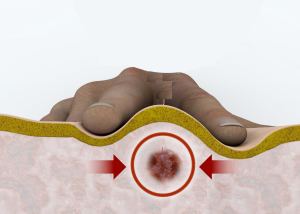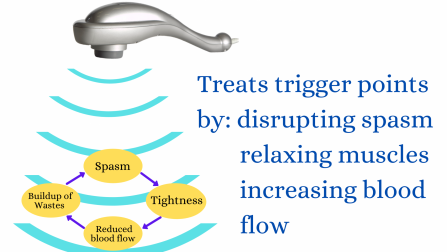How trigger points affect your muscles and Nervous system
In this section we will look at:
- the basic effects on the muscles
- the secondary effects of this on nervous system control
- these cannot be corrected with exercises
The basic effects on your muscles
Abnormal tightness
As previously stated the muscle contraction will cause the muscle with the trigger point to shorten and tighten. This will:
- restrict movement,
- the abnormal tension will cause issues like postural and biomechanical changes, and
- places extra stress where the muscles attach.
Please see example one below.
Reduced strength and rapid fatigue
Constantly tightening plus having a build up of wastes plus a lack of nutrients and oxygen, the muscle containing the trigger point will have reduced strength and fatigue faster.
Your muscle slow to act
Tests have shown that muscles in this state take longer to respond when it receives a signal from a nerve. See example two below.
The secondary effects of this on nervous system control
When everything is working as it should muscles work together like a symphony orchestra to do things like:
- balance,
- move in such a way that is the most efficient, and
- creates the least stress upon parts of your body such as your joints.
When your muscles are affected by trigger points your nervous system will compensate, affecting balance, coordination and tension. Please see examples three and four below.
Some examples
Example one: study of trigger points in the calf muscles of rugby players
In this trial scientists investigated the gastrocnemius (calf) muscles in pain free elite rugby players. They found that many had latent (not causing pain) trigger points causing abnormally tight bands of muscles. The scientists stated that these would limit activities such as vertical jumps and others requiring extension of the lower limbs. They recommended that early detection of these trigger points may also prevent possible muscle injuries (ÖZTÜRK et al., 2022).
Example two: study of effect of trigger points on muscle timing
In this trial people were asked to lift a weight as soon as they heard a sound signal. Those with trigger points in their muscles were compared with those without. It was found that the muscles with trigger points were 50-100 ms (0.05-0.1 seconds) slower to start contracting.(Yassin et al., 2015).
Example three: Investigation of the activity of shoulder muscles
The scientists used needle electrodes to detect and measure the activity of various shoulder muscles during movement. They found that latent (pain free) trigger points in the muscles affected the coordination and timing. The scientists stated that this would cause:
- inefficiency of movement
- incomplete muscle relaxation following exercise, and
- disordered fine movement control.
The scientists recommended that elimination of those trigger points may improve muscle function (Ibarra et al., 2011). This was confirmed by another researcher who found similar altered neurological control due to trigger points. In this study when the trigger points were treated control went back to normal (Lucas, Rich and Polus, 2007).
Example four: Effects of upper trapezius trigger points on scapular movement in athletes
The scientists compared the scapula (shoulder blade) movement of overhead athletes with and without trigger points in their upper trapezius muscles. They found that the presence of trigger points impaired scapula movement and associated muscular activities (Huang et al., 2022).
These cannot be corrected by exercises
As a side issue a lot of people try and correct this dysfunction with exercises. Researchers have tried this, but each time the underlying abnormal compensatory neurological control remained. These exercises will be performed in the (abnormal) compensatory manner, and be detrimental rather than helpful. The safe and effective way to correct these dysfunctions is to eliminate the issues that cause them. For more information about this please see our following articles.
Functional rehabilitation
Do exercises help shoulder pain





